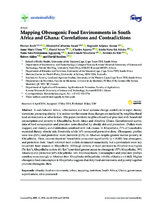| dc.contributor.author | Kroll, Florian | |
| dc.contributor.author | Swart, Elizabeth Catherina | |
| dc.contributor.author | Annan, Reginald Adjetey | |
| dc.date.accessioned | 2021-06-22T10:13:49Z | |
| dc.date.available | 2021-06-22T10:13:49Z | |
| dc.date.issued | 2019 | |
| dc.identifier.citation | Kroll, F.et al. (2019). Mappobesogenic food environments in South Africa and Ghana: Correlations and contradictions. Sustainability (Switzerland), 11(14), 1–31. https://doi.org/10.3390/su11143924 | en_US |
| dc.identifier.issn | 2071-1050 | |
| dc.identifier.uri | https://doi.org/10.3390/su11143924 | |
| dc.identifier.uri | http://hdl.handle.net/10566/6335 | |
| dc.description.abstract | In sub-Saharan Africa, urbanisation and food systems change contribute to rapid dietary transitions promoting obesity. It is unclear to what extent these changes are mediated by neighbourhood food environments or other factors. This paper correlates neighbourhood food provision with household consumption and poverty in Khayelitsha, South Africa and Ahodwo, Ghana. Georeferenced survey data of food consumption and provision were classified by obesity risk and protection. Outlets were mapped, and density and distribution correlated with risk classes. In Khayelitsha, 71% of households exceeded dietary obesity risk thresholds while 16% consumed protective diets. Obesogenic profiles were less (26%) and protective more prevalent (23%) in Ahodwo despite greater income poverty in Khayelitsha. Here, income-deprived households consumed significantly (p < 0.005) less obesogenic and protective diets. Small informal food outlets dominated numerically but supermarkets were key household food sources in Khayelitsha. Although density of food provision in Ahodwo was higher (76/km2), Khayelitsha outlets (61/km2) provided greater access to obesogenic (57% Khayelitsha; 39% Ahodwo) and protective (43% Khayelitsha; 16% Ahodwo) foods. Consumption and provision profiles correlate more strongly in Ahodwo than Khayelitsha (rKhayelitsha = 0.624; rAhodwo = 0.862). Higher obesogenic food consumption in Khayelitsha suggests that risky food environments and poverty together promote obesogenic diets. | en_US |
| dc.language.iso | en | en_US |
| dc.publisher | MPDI | en_US |
| dc.subject | Obesity | en_US |
| dc.subject | Food environments | en_US |
| dc.subject | Urban | en_US |
| dc.subject | Mapping | en_US |
| dc.subject | Nutrition | en_US |
| dc.subject | South Africa and Ghana | en_US |
| dc.title | Mapping obesogenic food environments in South Africa and Ghana: Correlations and contradictions | en_US |
| dc.type | Article | en_US |

